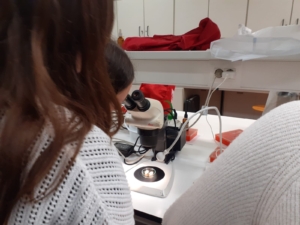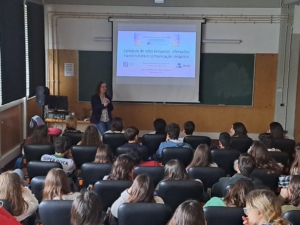Last March 17th, BioISI joined the Brain Awareness Week and hosted a visit from high-school students from Colégio de Santa Doroteia, in Lisbon. In this activity, students had the opportunity to attend two lectures and two workshops in the field of brain research.
The initiative included activities prepared by Diana Cunha-Reis, principal investigator from Epilepsy and Aging Lab, and Federico Herrera, principal investigator from Cell Structure and Dynamics Lab, both at Ciências ULisboa. By means of the two lectures held by those two BioISI researchers, respectively, on epilepsy of the frontal lobe and on neurodegenerative diseases, students were able to learn more about the mechanisms of those conditions and the brain functioning.
 Furthermore, through their participation on a hands-on activity regarding epilepsy in animal models and the visitto Federico Herrera’s Lab, pupils had the opportunity to “dive” into the research developed in these scientific fields.
Furthermore, through their participation on a hands-on activity regarding epilepsy in animal models and the visitto Federico Herrera’s Lab, pupils had the opportunity to “dive” into the research developed in these scientific fields.
When it comes to scientific knowledge, students found that this visit was an opportunity to consolidate Biology classes’ contents, as it is said by João Bernardo Antunes, from the 12th Grade: “(…) [the activity] allowed us to apply the what we learnt in practical situations, like, for example, when it was mentioned that ways of using stem cells to replace damaged neurons (…)”. Additionally, it was also time to learn something new, as suggested by Leonor Rodrigues and Marta Farinha, from the 11th Grade: “We didn’t know the difference between healthy cells and cells with neurodegenerative diseases, nor did we know what epileptic seizures were, among many other things we learned in these lectures. Here, we saw images and videos that helped us better understand the spoken phenomena.”
Besides appreciating the lectures, it seems also that students found that the hands-on activities and the lab visits were the high-point of the whole initiative: “An interesting aspect was that the visit became more interactive , from the moment we were able to observe healthy and epilepsy neurons and mouse brains and tried to distinguish them. Another activity that we really enjoyed was the visit to the university facilities, which included going through the various buildings and rooms where classes took place and seeing the laboratories where the students worked.”, explained Leonor Rodrigues and Marta Farinha.
, from the moment we were able to observe healthy and epilepsy neurons and mouse brains and tried to distinguish them. Another activity that we really enjoyed was the visit to the university facilities, which included going through the various buildings and rooms where classes took place and seeing the laboratories where the students worked.”, explained Leonor Rodrigues and Marta Farinha.
Another aspect highly appreciated by the students was the opportunity to talk with young BioISI researchers (MSc. and PhD students). Regarding this, João Bernardo Antunes highlights that: “We were able to ask questions to the faculty students working there This helped us to become aware of the faculty environment [and] (…) they answered the questions we asked them, letting us know the materials and laboratory techniques they used, as well as the work they were developing”.
In Inês Carvalho’s opinion, this was a positive experience for her pupils, as she refers that: “The participation of the 11th and 12th grade students of Colégio de Santa Doroteia in this activity (…) is very important to me as a biology teacher. This activity allows the contact with researchers and is an excellent introduction to the university environment in which these students will soon be inserted.” This is not the first Inês Carvalho in an outreach activity promoted by BioISI within the Brain Awareness Week for she says: “We always feel very welcome by the researchers and we appreciate their availability.” However, BioISI is the one who must be grateful for this opportunity on which the researchers were able to share the work they develop in the institute and passionate young people towards Science.
Find out more about Diana Cunha-Reis and her current research here.
Get to know the Cell Structure and Dynamics Lab, both at Ciências ULisboa here


Photo Credits: BioISI Communication and Diana Cunha-Reis

